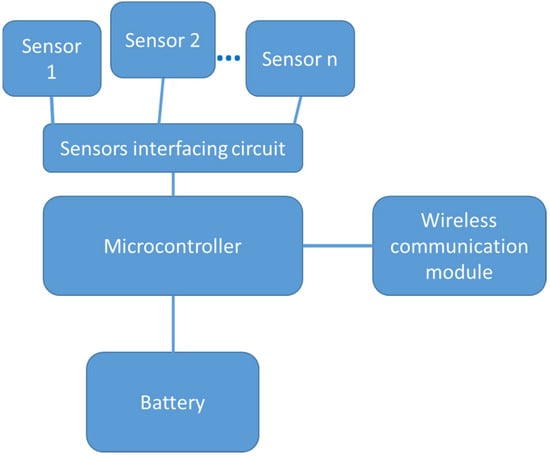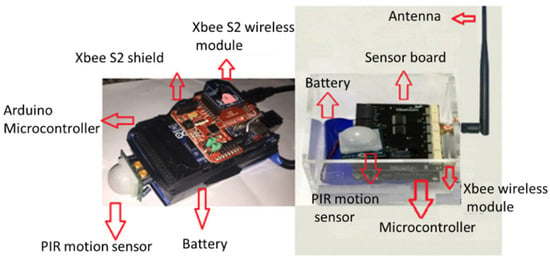You're using an outdated browser. Please upgrade to a modern browser for the best experience.
Please note this is an old version of this entry, which may differ significantly from the current revision.
Despite numerous research efforts in the fast-growing field of wireless sensor devices, energy consumption remains a challenge that limits the lifetime of wireless sensor networks (WSNs). The Internet-of-Things (IoT) technology utilizes WSNs for providing an efficient sensing and communication infrastructure. Thus, a comparison of the existing wireless sensor nodes is crucial. Of particular interest are the advances in the recent MCU-based wireless sensor node platforms, which have become diverse and fairly advanced in relation to the currently available commercial WSN platforms.
- Internet-of-Things (IoT)
- wireless sensor networks
- sensor node
1. Introduction
Of late, there have been numerous research efforts in the fast-growing field of wireless sensor devices. This is being driven by the advent of many Internet-of-Things (IoT) applications and scenarios that utilize wireless sensor networks (WSNs) for providing an efficient sensing and communication infrastructure. A wireless sensor network consists of distributed wireless sensor nodes or motes that can be used for detecting various physical and environmental phenomena. The nodes collaboratively send the sensed data to a base station or sink for further processing and decision-making. Examples of sensed parameters include temperature, pressure, moisture, motion, liquid level, etc. Wireless sensor networks are very useful in a wide range of applications that include environmental monitoring, precision agriculture, IoT, water quality monitoring, animal tracking and so forth [1,2,3,4]. Overas the years, several practical wireless sensor nodes or motes have been developed and introduced in the market to facilitate the implementation of various wireless sensor network scenarios. Advancements in wireless sensor node technologies [5] facilitate the cutting-edge research and real-world implementation of WSNs in countless applications around the globe.
A sensor node typically consists of the sensing, computation, communication and power supply sub-systems. The wireless sensor node platforms are resource-constrained when it comes to the power supply, computation and storage capabilities, etc. [6]. Some of the objectives of designing and developing a wireless sensor node include ultra-low- power operation, low cost per node, small size and reconfigurable software and hardware. The designing of increasingly smaller and more affordable wireless sensor node platforms of ultra-low power consumption has become a hot research topic for the research community [7].
The lifetime of a WSN strongly depends on the supply of energy for powering the sensor motes. Traditionally, sensor nodes are powered by small batteries of limited capacities. In numerous application scenarios, many deployed sensor motes are required to last unattended for an unlimited lifetime in remote and harsh fields. In such deployment scenarios, battery replacement becomes a big challenge. The energy consumption of the motes directly impacts the lifetime of the WSNs. Therefore, ultra-low power approaches together with energy-harvesting techniques are critical towards the ubiquitous and perpetual operation of WSNs [8]. Due to the different requirements of various WSN applications, different wireless sensor node platforms are being developed. For instance, some tracking and monitoring application scenarios of WSNs require the use of wearables.
Over the years, several wireless sensor nodes based on the MCU, field programmable gate arrays (FPGAs), system-on-chip (SoC), application-specific integrated circuit (ASIC) and other platforms have been designed and developed [9]. In the literature, there is a limited number of review articles on wireless sensor node platforms. In 2009, [10] presented a comparative review of only six selected sensor motes. Authors in [2] provided a survey on the protocols, platforms and simulation tools of selected wireless sensor platforms. A comparison of the performance of two commercial motes in practical situations was performed by [11]. A review of sensor motes targeted only for IoT applications was presented in 2018 by [12]. However, in this proposed study, the selected wireless sensor nodes are used for a wide range of applications. Furthermore, the authors of [9] provided a detailed review on wireless sensor nodes spanning from simple MCU-based to complex programmable logic devices.
In the literature, there are several other published articles that list and compare different motes that can be used for different IoT applications [13,14,15,16,17]. However, these articles do not include the motes that have been recently proposed and published in the literature. Furthermore, the cited articles do not have detailed comparisons and descriptions of these motes, while this paper lists the most recent motes published in the literature and provides more comparison details, which makes it very valuable to IoT application developers and solution providers.
2. Wireless Sensor Node
Although several wireless sensor node platforms based on the MCU have been proposed, they generally have the same basic architecture. They differ with regard to processing and memory specifications, communication capabilities, power supply and consumption, sensor support, applications and so on. A basic wireless sensor node consists of the sensing (sensors interfacing and sensors), computation (a microcontroller), communication and power supply sub-systems as depicted in Figure 1.

Figure 1. Basic architecture of a sensor node [13].
2.1. Sensing Sub-System
Sensors convert physical phenomena into electrical signals [5]. Therefore, the sensing sub-system links the node to the environment. Digital or analogue signals are obtainable from the sensors. The sensors’ interfacing circuit enables the microcontroller to process the detected signals. Some of the existing node platforms have embedded or built-in sensors while others do not. Several sensor nodes have sockets capable of accommodating a variety of sensors to be connected thus provisioning for flexibility.
2.2. Computation Sub-System
The tasks of the microcontroller include the processing of the signals coming from the sensing sub-system and transceiver, and coordinating the activities of other sensor mote components [14]. The major goal of the central processing unit (CPU) core is to ensure correct program execution. Thus, the CPU should have the ability to perform tasks such as accessing memories, performing computations, coordinating external devices and interrupt handling. Processors in sensor motes are capable of functioning in different operational modes such as active, idle and sleep modes as the least to mitigate unnecessary power consumption. The storage section of the mote normally comprises the flash memory and random access memory (RAM). The flash memory stores the program code for the sensor mote and facilitates high speed sampling and flexible program updates while the RAM is utilized for the storage of sensed information and any data required for performing computations [15]. The electrically erasable programmable read-only memory (EEPROM) can be used for the storage of the information for identifying the registered sensor motes in the network [16]. Some of the motes have an embedded micro–secure digital (SD) card interface to provide the mote with a non-volatile memory for off-line data capturing. However, the process of writing to the SD card is power-demanding.
2.3. Communication Sub-System
The communication subsystem comprises a radio module or transceiver for facilitating the reception and transmission of signals to and from the wireless sensor motes, and also to a base station or sink [14]. Radio frequency (RF) communication is suitable for WSNs because it is not limited by line-of-sight (LOS) and recent advances allow the utilization of low-power radio modules with data rates and communication ranges adjustable depending on the application scenarios.
2.4. Power Supply Sub-System
The power supply sub-system usually consists of a battery and/or a supercapacitor for storing and powering the sensor node. For the different application scenarios of wireless sensor networks, the intended lifetime of the sensor nodes may be several years, and battery replenishment or replacement can be costly, inconvenient or even impossible, especially in large-scale, remote and hazardous environments. Therefore, designers introduce ultra-low-power and energy-efficient sensor nodes including the associated communication protocols and the motes’ sleep/awake mode schedules. Energy harvesting from potential sources such as RF signals, solar, vibrations and so on may also be incorporated to recharge the batteries [17].
3. MCU-Based Hardware Platforms for Wireless Sensor Nodes
This section provides a review of wireless sensor nodes from recently published research articles and the popular commercially available motes with respect to their potential applications, processor and memory specifications, communication capabilities, sensor support, power supply and power consumption. The sensor nodes from recent research works were selected from internationally recognized databases. The commercially available motes (MICAz, IRIS, LOTUS, WiSense and Waspmote Plug & Sense!) were selected for comparison in this study based on a number of criteria including popularity, published results and interesting characteristics and features. The popular MiCAz mote from CrossBow Technology, though not recent, was chosen as one of the reference motes for comparison. A snapshot of typical wireless sensor nodes from a recently published research article is shown in Figure 2.

Figure 2. Images of two typical MCU-based wireless sensor nodes [18].
In what follows, a discussion about the recently proposed wireless sensor nodes published in the period from 2016 to 2022 and the commercially available wireless sensor nodes is provided. These nodes are categorized according to their potential applications such as: human monitoring and tracking, environmental monitoring and smart farming, smart cities, automotive applications, general IoT applications and seismic monitoring applications. The discussion focuses on the wireless sensor nodes’ applications, processing and memory specifications, communication capabilities, sensor support, power supply specifications and power consumption.
This entry is adapted from the peer-reviewed paper 10.3390/s22228937
This entry is offline, you can click here to edit this entry!
